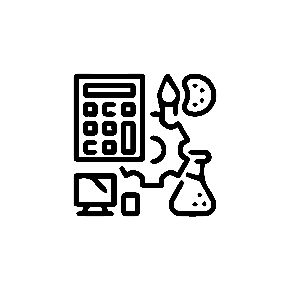Your One Stop Shop for Educational Resources
Structural
Meiosis Model, Unmounted
Robust models illustrating the process of meosis cell division. The chromosomes are painted to allow easy identification.
592.88 AED
Dynamic DNA Kit
The kit contains the following: 12 base Pairs Includes 6 A-T and 6 G-C base pairs; 5' hydrogen and 3' oxygen parts; oxygen atoms to model RNA; removable carbons for uracil; ATP, TTP, GTP and CTP models; display stand; teacher resources and lessons.
2222.89 AED
Mitosis Model, Unmounted
Eight individual models illustrating the process of mitotic cell division for a general animal cell. Chromosomes and centromeres are brightly painted to easily identify and explain each step of cell division. Each model is approx. 100 x 150 mm.
502.76 AED
Amino Acid Starter Kit
Explore the primary, secondary and tertiary structure of proteins with the captivating models and tools in this dynamic kit. This engaging, hands-on protein folding kit makes teaching protein structure basics easy. Students will fold a protein while exploring how the chemical properties of amino acids determine its final structure. Students can use the Amino Acid Starter Kit© to: •Learn that the 20 amino acids all share a common backbone but have different side chains, each with different chemical properties. •Identify the chemical properties of the side chains through a dual colouring scheme guided by the kit’s chemical properties circle, amino acid side chain list and coloured plastic clips. •Group the side chains into one of 5 categories: hydrophobic (nonpolar), hydrophilic (polar), negatively charged, positively charged, and cysteines, which sometimes form disulphide bonds. The coloured clip at the base of each side chain indicates chemical properties while embedded coloured balls in the amino acid side chain model show atomic structure. •Employ the kit’s protein-folding activities to first explore the primary and tertiary structure of proteins by constructing a generic 15-amino acid protein, then learn about the secondary structure of proteins by folding a toober model of the first of 3 zinc fingers of the Zif268 protein. Each 1-group set includes 1 chemical properties circle, 1 amino acid side chain chart, 22 amino acids, 1 mini toober, 22 coloured plastic clips and 6 hydrogen bond connectors.
470.35 AED
Modelling Mini-Toobers
These versatile modelling Toobers provide hands-on learning experiences in biology and chemistry. Students can model DNA or create protein structures and explore basic protein-folding principles. Toobers are flexible foam rods which have soft wire core that allows them to hold their shape well and they can be simply straightened out afterwards and re-used. Length: 120 cm long. Please note that theses are sold individually and the push pins are not included. See also 'Amino Acid Starter Kit' (MO110150). Also useful for teaching: • How hydrophilic/hydrophobic side-chains influence protein's structure • How structure is critical factor in many protein's function
86.96 AED
DNA Starter Kit, 1 Group Set
Students will immediately become engaged with this interactive foam model of double-stranded DNA and single-stranded RNA. The DNA Starter Kit© is schematic model that transforms from the familiar ladder shape to the double helix with twist. Students can explore the structure of colour-coded DNA bases showing purines and pyrimidines which connect to continuous sugar-phosphate backbone. Then they can delve into replication and transcription. Using individual nucleotide triphosphates, they can synthesize new strand of DNA one base at time showing the semi-conservative replication of DNA. Finally they can synthesize mRNA one base at time to show the process of transcription. Each kit includes: 51 bases (12 red adenine, 12 yellow thymine, 12 blue cytosine, 12 green guanine, 3 white uracil), 4 continuous grey backbones, 24 grey sugar-phosphates, 12 lavender sugar-phosphates and 48 orange phosphates.
261.66 AED
Demo DNA Nucleotides
The sky is the limit to what you can teach using these new large-scale, colour-coded foam nucleotides. Begin by teaching the complementary A-T and C-G base pairs and the antiparallel nature of double-stranded DNA. Move on to the flow of genetic information as you teach the basic processes of semiconservative DNA replication and mRNA transcription. You can then stretch students by introducing PCR (polymerase chain reaction) and the Sanger DNA sequencing method -- and much more. 80 Large-Scale Nucleotides: • 20 Red Adenosine • 20 Yellow Thymine • 20 Blue Cytosine • 20 Green Guanine 80 Adhesive-Backed Round Magnets
331.22 AED
DNA - RNA Model
The model shows DNA and transcription of RNA. Height approx 500 mm. Complete with stand, instructions and model description.
162.05 AED
Mini DNA® Molecular Model Kit, 12 Layer
Comprising abstract shaped colour coded parts to represent the nitrogenous bases, pentagonal sugar and pyramidal phosphate parts required to make the Double Helix model of DNA. The model can be displayed on its stand or untwisted into either flat or ladder form. The kits are designed so that only complimentary bases can be joined together. Scale 10 mm 2 Angstroms, 12 layer. The kit comes with stand and full instructions.
173.91 AED
Mini DNA® Molecular Model Kit, 22 Layer
Comprising abstract shaped colour coded parts to represent the nitrogenous bases, pentagonal sugar and pyramidal phosphate parts required to make the Double Helix model of DNA. The model can be displayed on its stand or untwisted into either flat or ladder form. The kits are designed so that only complimentary bases can be joined together. Scale 10 mm 2 Angstroms, 22 layer. The kit comes with stand and full instructions.
306.71 AED
Beta Globin Folding Kit
Proteins become real in your students' hands with this as they fold Mini-Toober ß-Globin fragments and discover the primary, secondary and tertiary structure in this model. Maps guide your students in folding the Mini-Toobers into ß-Globin's 3-D shape. This Kit is the next step in helping your students understand proteins, after engaging in the Amino Acid Starter Kit© activities. The Mini-Toober ß-Globin Folding Kit© includes Mini-Toobers, folding map guides, amino acid side-chains, haeme group, iron atom, oxygen atoms, and an assortment of parts to mark and connect the fragments. The Folding Kit can be used successfully by to students working in teams. Available as kit for self-construction, or ready-made, pre-folded model.
1350.96 AED























































